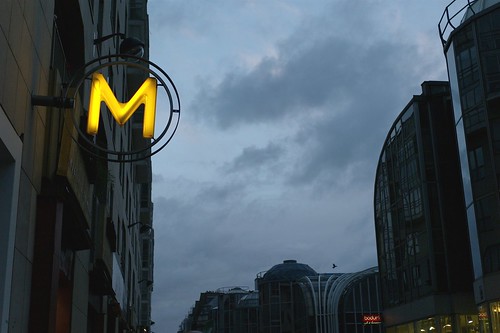C
chris_tribble
Guest
Some good news and some (sort of) bad. Picked up a GRD2 yesterday from the nice people at RG Lewis + the 21-28 finder (for a ridiculously cheap £40 - go and get one while they're still in stock!).
THE CAMERA
In my hands the GR is TINY - makes it difficult to feel confident holding it + the wrist strap's on the wrong side for me, so not particularly useful... Second, it was easy to set up and is proving to be easy to use (the focus light being within periferal vision when you're using the finder is very helpful).
IMAGES
NOISE
I was working at 400 and 800 and have no problems with noise given the sensor size. Compared with the M8 or the 5D or 1D2 which I normally work with, it's noisy, but it's not aesthetically problematic, and the images are more than useable. I have no experience with the GRD1 so can't join in the discussion about better / worse, but from someone whose last small sensor camera was an Ixus vintage 2004, this is a completely different ball game.
DOF
I attach a couple which are beginning to give me an idea of what I'll be able to do with the tool. First, the restaurant shot brings home forcibly the limitation (or some would say strength) of small sensor cameras. The lens was fully open, but the DOF is so great that things on the other side of the room are still highly (and for me) distractingly visible. F2.4 on any of the Leica lenses would be giving OOF 5 or 10 cms on either side of the in-focus and a much better image (from my point of view). Clearly this is something to get used to!
DR
I was aware that the dynamic range of the small sensor would be restricted, but was a bit surprised by the effect of bright light within the frame... rather than giving a stepless gradation from blown to not blown, there's a strange concentric ring effect that's very digital ... Again, something to get used to and to learn to overcome by spot metering and working more carefully.
OVERALL
The good news is that the GRD2 is going to be fun to learn how to use, is incredibly portable, and with the finder, feels spontaneous and easy to use... Lots of things to play with, but the basic sense of it being a photographic tool that's going to usefully complement my other systems.
Thanks to all on the list who introduced me to the GRD2.
Best
Chris
THE CAMERA
In my hands the GR is TINY - makes it difficult to feel confident holding it + the wrist strap's on the wrong side for me, so not particularly useful... Second, it was easy to set up and is proving to be easy to use (the focus light being within periferal vision when you're using the finder is very helpful).
IMAGES
NOISE
I was working at 400 and 800 and have no problems with noise given the sensor size. Compared with the M8 or the 5D or 1D2 which I normally work with, it's noisy, but it's not aesthetically problematic, and the images are more than useable. I have no experience with the GRD1 so can't join in the discussion about better / worse, but from someone whose last small sensor camera was an Ixus vintage 2004, this is a completely different ball game.
DOF
I attach a couple which are beginning to give me an idea of what I'll be able to do with the tool. First, the restaurant shot brings home forcibly the limitation (or some would say strength) of small sensor cameras. The lens was fully open, but the DOF is so great that things on the other side of the room are still highly (and for me) distractingly visible. F2.4 on any of the Leica lenses would be giving OOF 5 or 10 cms on either side of the in-focus and a much better image (from my point of view). Clearly this is something to get used to!
DR
I was aware that the dynamic range of the small sensor would be restricted, but was a bit surprised by the effect of bright light within the frame... rather than giving a stepless gradation from blown to not blown, there's a strange concentric ring effect that's very digital ... Again, something to get used to and to learn to overcome by spot metering and working more carefully.
OVERALL
The good news is that the GRD2 is going to be fun to learn how to use, is incredibly portable, and with the finder, feels spontaneous and easy to use... Lots of things to play with, but the basic sense of it being a photographic tool that's going to usefully complement my other systems.
Thanks to all on the list who introduced me to the GRD2.
Best
Chris



